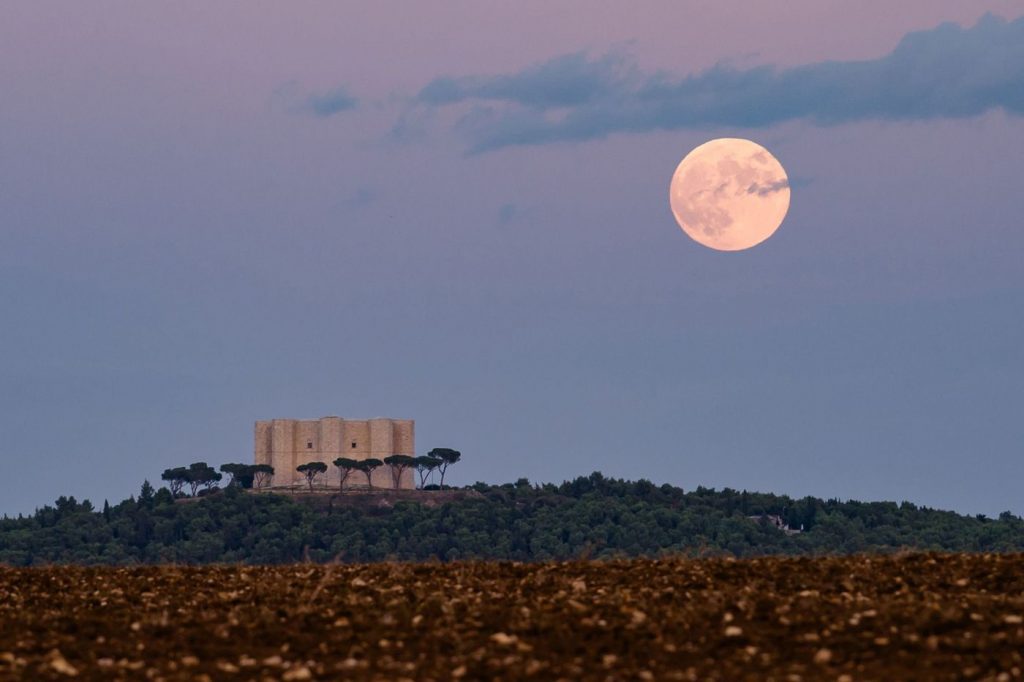Keep your eyes along the horizon at dusk to witness a stunning lunar display rise this evening. The closest supermoon of the year will soon loom large and bright in the autumn sky.
October’s hunter’s moon is set to peak at its fullest around 7:26 a.m. ET Thursday, but the silvery orb will appear round Wednesday evening through Friday morning, according to NASA.
REALTED: There’s still time to see a spectacular comet, before it’s gone, maybe forever
This full moon is considered the third of four consecutive supermoons expected this year, NASA says.
The celestial phenomenon happens a few times during every lunar cycle because the moon’s orbit is elliptical, meaning there are intervals when Earth’s only permanent natural satellite is closer or farther from the planet.
Along the lunar orbital path, the point of closest proximity is known as perigee, which is when the moon is, on average, 226,000 miles (363,300 kilometers) from Earth. When a full moon phase coincides with perigee, a supermoon event occurs.
What makes a supermoon special
Related Articles
There’s still time to see a spectacular comet, before it’s too late
Some amazing things are going on above our heads. This moon isn’t one of them.
The Perseids are here. Here’s how to see the ‘fireballs’ of summer’s brightest meteor shower
Ever see a star explode? You’re about to get a chance very soon
Perseids meteor shower on view Aug. 12 in Santa Clara Valley
Supermoon is a term that describes the moon when it is closer to Earth than normal.
Typically, the moon orbits an average distance of about 238,855 miles (384,400 kilometers) from its host planet, but during this month’s supermoon, it will be just 222,095 miles (357,428 kilometers) from Earth, making it the closest full moon of 2024.
During a supermoon event, the orb may appear as much as 8% larger and 16% brighter than an average-size full moon, according to EarthSky.
October’s moon is not actually larger or brighter than any other moon, but it may appear that way because it’s viewed near the horizon shortly after sunset, said Dr. Robin L. Shelton, a professor of physics at the University of Georgia.
Many people associate the hunter’s moon with being orange in color as it rises, but the same could be said of all full moons. The color, Shelton explained, is a result of optical effects involving light passing through Earth’s atmosphere.
Why the full moon is called hunter’s moon
The hunter’s moon is the first full moon after the autumnal equinox, which occurred on September 22 this year. The lunar event marks the changing of the seasons.
The name originated from indigenous people, who benefited from the bright appearance of the moon as hunters prepared for long winters. Hunting also tended to be easier during this time of year because the fields had already been cleared out, according to The Old Farmer’s Almanac.
Other names for October’s full moon across various indigenous peoples include the moon of the first frost from the Potawatomi nation, time when the corn is taken in from the Apache tribe or falling leaves moon from the Anishinaabe people.
Traditions around this time include the Feast of the Hunter’s Moon, an annual re-creation of the mid-1700s fall gatherings of French and Native Americans at Fort Ouiatenon, 4 miles (6.4 kilometers) southwest of West Lafayette, Indiana.
The hunter’s moon is expected to be joined by Jupiter, a red giant star called Aldebaran and the star cluster Pleiades, according to EarthSky. Depending on your location, these cosmic wonders may be visible Friday and Saturday night through dawn.
Upcoming celestial events
Comet C/2023 A3 (Tsuchinshan-ATLAS), which just made its closest pass of Earth on Saturday, is visible in the west just after sunset. Look for the celestial wonder and its long tail streaking across the sky through October 24. While it may be visible with the naked eye, binoculars or a small telescope will certainly help. Don’t miss your chance to spot the comet, which won’t circle back around again for at least 80,000 years.
Keep an eye out for bright Jupiter, which will appear near the moon low in the eastern sky around 10 p.m. on October 20, and Mars will look like a red dot near the moon high overhead in the early morning hours of October 23 and 24, according to NASA.
The beaver moon on November 15 is the fourth and final supermoon of the year. And the cold moon on December 15 will be the last full moon of 2024.
And here are peak dates for remaining fall and winter meteor showers, according to the American Meteor Society.
• Orionids: October 21-22
• Southern Taurids: November 5-6
• Northern Taurids: November 11-12
• Leonids: November 17-18
• Geminids: December 13-14
• Ursids: December 21-22
The-CNN-Wire
& © 2024 Cable News Network, Inc., a Warner Bros. Discovery Company. All rights reserved.


